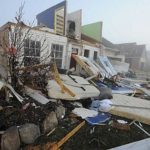Take Sever Weather Seriously & Prepare
- Heed severe weather watches and warnings. They exist for your safety. As a reminder:
- A Severe Thunderstorm Watch means severe thunderstorms are possible in and around the watch area. Use caution when outdoors, and keep an eye on the sky.
- A Tornado Watch means conditions are favorable for the development of tornado-producing thunderstorms in and around the watch area. A tornado watch provides you with time to prepare in case weather conditions rapidly deteriorate.
- A Severe Thunderstorm Warning means thunderstorms with winds in excess of 58 mph and/or hail larger than 1 inch in diameter are occurring in your immediate area. Take shelter immediately. Severe thunderstorms can and do produce tornadoes.
- A Tornado Warning means a tornado is imminent or already on the ground in your immediate area, indicated by Doppler radar and/or trained weather spotters. Take shelter immediately. THIS IS A LIFE THREATENING SITUATION.
- Obtain a battery-operated NOAA weather radio. NOAA weather radios pick up special messages that are not broadcast on traditional AM or FM frequencies, and they alert to special emergency tones, which can wake you if you are sleeping and a severe weather warning is issued for your area. They can also alert you to other disasters or national security situations. For more information on NOAA Weather Radios, visit: www.nws.noaa.gov/nwr
- Enable Wireless Emergency Alerts (also called Emergency Alerts) on your mobile phone, if your phone supports them. Wireless Emergency Alerts are emergency messages sent by authorized government alerting agencies (such as the National Weather Service) via mobile carriers to all enabled devices within a specific area which may be in harm’s way, without the need to download an app or a subscribe to a service. For more information on Wireless Emergency Alerts, visit www.nws.noaa.gov/com/weatherreadynation/wea.html
- Plan ahead. Make sure everyone in your household knows what to do and where to go in case of a severe thunderstorm or tornado warning. Have a plan in place in case of severe weather. Don’t forget about your pets, and make sure they are always wearing ID.
- Know the safest location for shelter in your home, workplace, and school. Load-bearing walls near the center of the basement or lowest level of the building provide the best protection.
- If you can hear thunder, you are within range to be struck by lightning. Immediately go to the nearest large building, or to a fully enclosed hard-top vehicle (soft-topped convertibles are not safe). It is not safe anywhere outside.
- Telephone lines and metal pipes can conduct electricity. Any item plugged into an electrical outlet can cause a hazard during a thunderstorm or tornado. Do not bathe or take a shower during a thunderstorm. Do not use corded (plug-in) telephones except in an emergency. Cordless telephones (including cell phones) are safe to use.
- Stay away from windows, doors, and outside walls during a severe thunderstorm or tornado warning. Broken glass and wind-blown projectiles cause more injuries and deaths than collapsed buildings. Protect your head with a pillow, blanket, or mattress.
- Do not call 911 to report weather phenomena such as lightning, hail, strong wind, or power outages. Only dial 911 for life-threatening situations and emergencies. Downed power lines, lightning strikes to your home, tornadoes on the ground, injured or trapped persons, structural collapse, fires, natural gas leaks, and flash flooding completely covering the roadway are all storm-related conditions where it is acceptable to call 911.
- After severe weather passes, use extreme caution when venturing out of your home. Downed power lines can be very difficult to see, and are deadly, even at a distance. Unstable trees or structures can collapse, causing injury or death.
- Never attempt to cross a flooded road. A small amount of standing water may look harmless, but flooding causes more deaths than any other form of severe weather. It only takes a few inches of swiftly moving water to knock a person off their feet. As little as 6-12 inches of swiftly moving water can float some vehicles and carry them away.For more weather-related information, including up-to-the-minute watch and warning information, visit the website of the Detroit/Pontiac Office of the National Weather Service at: www.weather.gov/dtx
Weather Watch and Warning Explanations

